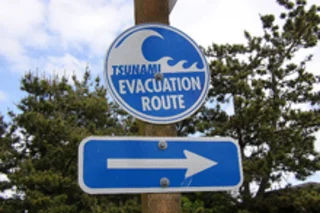Manoj Nair of the National Oceanic and Atmospheric Administration has devised a new possible method of detecting a deadly tsuami long before the wave crests to dangerous heights. And, in a bit of good news, much of it is already in place. In a new study in next month's Earth, Planets, and Space, Nair modeled the massive 2004 tsunami in the Indian Ocean and found that a tsunami picking up steam as it moves across the ocean emits a tiny electromagnetic signature of of about 500 millivolts. That's enough to have an effect on the communication cables that stretch across the ocean floor, carrying internet messages and phone calls. The electromagnetic signal
Nair says this kind of system could be a lower-cost alternative to the bottom pressure arrays that directly measure large movements of water.
"is very small compared to a 9-volt battery, but still large enough to be distinguished ...














